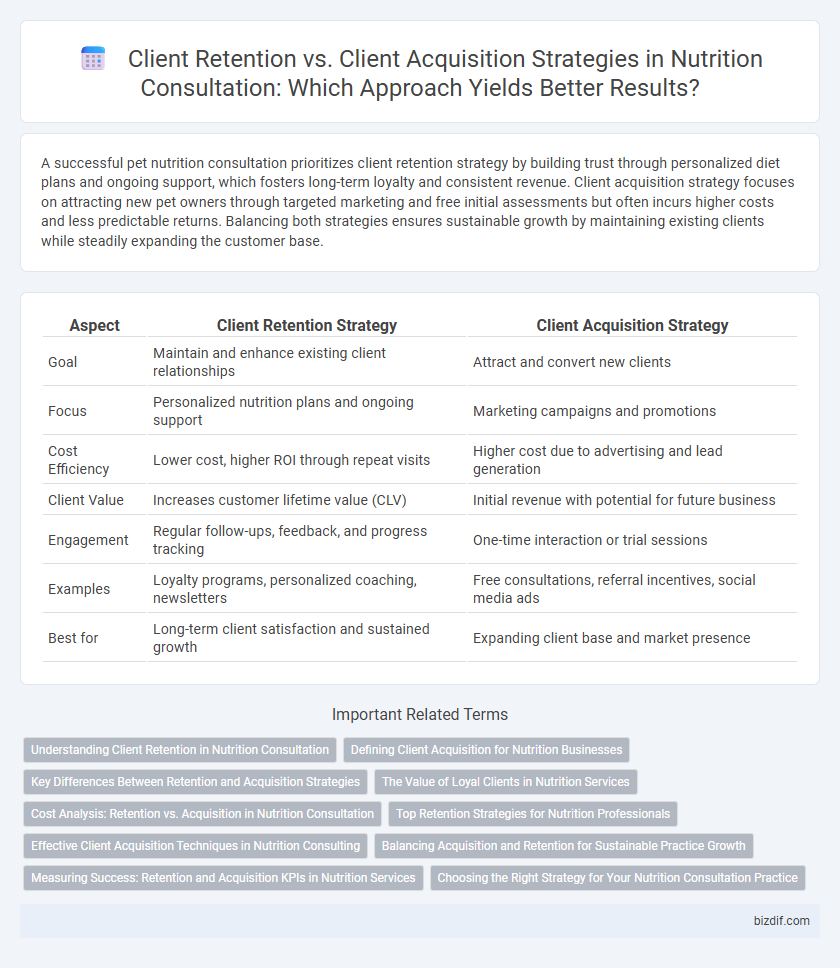A successful pet nutrition consultation prioritizes client retention strategy by building trust through personalized diet plans and ongoing support, which fosters long-term loyalty and consistent revenue. Client acquisition strategy focuses on attracting new pet owners through targeted marketing and free initial assessments but often incurs higher costs and less predictable returns. Balancing both strategies ensures sustainable growth by maintaining existing clients while steadily expanding the customer base.
Table of Comparison
| Aspect | Client Retention Strategy | Client Acquisition Strategy |
|---|---|---|
| Goal | Maintain and enhance existing client relationships | Attract and convert new clients |
| Focus | Personalized nutrition plans and ongoing support | Marketing campaigns and promotions |
| Cost Efficiency | Lower cost, higher ROI through repeat visits | Higher cost due to advertising and lead generation |
| Client Value | Increases customer lifetime value (CLV) | Initial revenue with potential for future business |
| Engagement | Regular follow-ups, feedback, and progress tracking | One-time interaction or trial sessions |
| Examples | Loyalty programs, personalized coaching, newsletters | Free consultations, referral incentives, social media ads |
| Best for | Long-term client satisfaction and sustained growth | Expanding client base and market presence |
Understanding Client Retention in Nutrition Consultation
Client retention in nutrition consultation hinges on personalized care and continuous support, which fosters trust and enhances long-term dietary compliance. Consistent follow-ups and adaptive nutrition plans improve client satisfaction and encourage loyalty, reducing churn rates significantly. Leveraging data-driven insights to address individual progress and challenges ensures a higher lifetime value per client compared to solely investing in client acquisition strategies.
Defining Client Acquisition for Nutrition Businesses
Client acquisition for nutrition businesses involves targeted marketing efforts, personalized consultations, and strategic outreach to attract new clients seeking dietary guidance and health improvements. Emphasizing educational content, leveraging social media platforms, and offering introductory sessions helps convert prospects into loyal clients. Effective acquisition strategies ultimately drive business growth by expanding the client base and increasing brand visibility in the competitive nutrition market.
Key Differences Between Retention and Acquisition Strategies
Client retention strategy in nutrition consultation emphasizes personalized follow-up, ongoing support, and building long-term trust with existing clients to enhance loyalty and repeat visits. Client acquisition strategy focuses on attracting new clients through targeted marketing, promotional offers, and educational outreach to expand the customer base. The key difference lies in retention aiming to maximize lifetime value of current clients, while acquisition prioritizes increasing overall client numbers.
The Value of Loyal Clients in Nutrition Services
Loyal clients in nutrition services generate consistent revenue and provide valuable word-of-mouth referrals that reduce marketing costs. Retention strategies emphasize personalized meal plans, regular progress check-ins, and ongoing education to deepen client trust and satisfaction. In contrast, acquisition efforts focus on attracting new clients through promotions and outreach, but investing in existing clients yields higher lifetime value and business stability.
Cost Analysis: Retention vs. Acquisition in Nutrition Consultation
Client retention in nutrition consultation typically costs 5 to 25 times less than acquiring a new client, making retention strategies more cost-effective. Maintaining existing clients through personalized follow-ups and tailored nutrition plans reduces marketing expenses and maximizes lifetime client value. Investment in retention results in higher ROI compared to acquisition, emphasizing the financial benefit of focusing resources on loyal clients.
Top Retention Strategies for Nutrition Professionals
Top retention strategies for nutrition professionals include personalized follow-up sessions, tailored meal plans, and regular progress tracking to foster long-term client commitment. Leveraging client feedback to continuously improve services enhances satisfaction and promotes loyalty. Incorporating digital tools such as mobile apps for meal logging and virtual check-ins streamlines communication and supports sustained engagement.
Effective Client Acquisition Techniques in Nutrition Consulting
Effective client acquisition techniques in nutrition consulting include targeted social media advertising that highlights personalized meal planning and evidence-based dietary advice. Leveraging online reviews and testimonials enhances credibility and attracts health-conscious individuals seeking customized nutrition guidance. Offering free initial assessments or workshops can also engage potential clients by showcasing expertise and value upfront.
Balancing Acquisition and Retention for Sustainable Practice Growth
Balancing client retention and acquisition strategies is crucial for sustainable growth in a nutrition consultation practice, as retaining existing clients reduces marketing costs and fosters long-term loyalty. Effective retention techniques include personalized follow-ups, continuous support, and offering value-added services, which increase client satisfaction and referral rates. Simultaneously, targeted acquisition efforts using digital marketing, educational content, and community engagement attract new clients, ensuring a steady influx while maintaining a strong, loyal client base.
Measuring Success: Retention and Acquisition KPIs in Nutrition Services
Measuring success in nutrition services requires distinct KPIs for client retention and acquisition strategies, such as client satisfaction scores, repeat consultation rates, and retention duration for retention metrics, compared to lead conversion rates, new client sign-ups, and cost per acquisition for acquisition metrics. Retention KPIs highlight long-term client engagement and sustained health improvements, whereas acquisition KPIs emphasize growth potential and market reach. Balancing these metrics enables nutritionists to optimize service quality and expand their client base efficiently.
Choosing the Right Strategy for Your Nutrition Consultation Practice
Focusing on a client retention strategy increases lifetime customer value by fostering trust and personalized nutrition plans that encourage ongoing engagement in your nutrition consultation practice. Investing in client acquisition strategy targets expanding your client base through targeted marketing campaigns and educational content tailored to prospective clients seeking nutritional guidance. Evaluating your practice's growth stage and budget allocation helps determine whether prioritizing retention or acquisition aligns best with your business objectives and maximizes overall sustainable revenue.
Client Retention Strategy vs Client Acquisition Strategy Infographic

 bizdif.com
bizdif.com